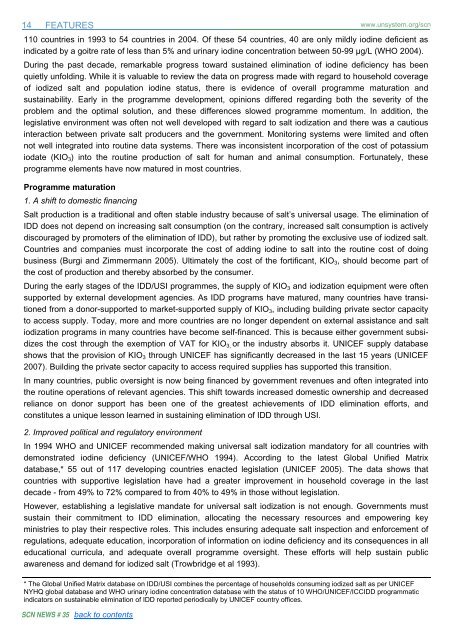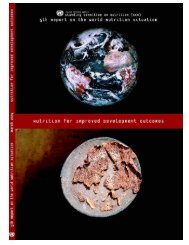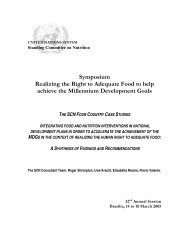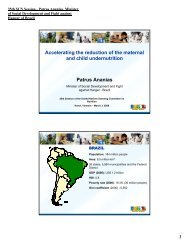Universal Salt Iodization (USI) - FTP Directory Listing
Universal Salt Iodization (USI) - FTP Directory Listing
Universal Salt Iodization (USI) - FTP Directory Listing
- No tags were found...
Create successful ePaper yourself
Turn your PDF publications into a flip-book with our unique Google optimized e-Paper software.
14FEATURES110 countries in 1993 to 54 countries in 2004. Of these 54 countries, 40 are only mildly iodine deficient asindicated by a goitre rate of less than 5% and urinary iodine concentration between 50-99 μg/L (WHO 2004).During the past decade, remarkable progress toward sustained elimination of iodine deficiency has beenquietly unfolding. While it is valuable to review the data on progress made with regard to household coverageof iodized salt and population iodine status, there is evidence of overall programme maturation andsustainability. Early in the programme development, opinions differed regarding both the severity of theproblem and the optimal solution, and these differences slowed programme momentum. In addition, thelegislative environment was often not well developed with regard to salt iodization and there was a cautiousinteraction between private salt producers and the government. Monitoring systems were limited and oftennot well integrated into routine data systems. There was inconsistent incorporation of the cost of potassiumiodate (KIO 3 ) into the routine production of salt for human and animal consumption. Fortunately, theseprogramme elements have now matured in most countries.Programme maturation1. A shift to domestic financing<strong>Salt</strong> production is a traditional and often stable industry because of salt’s universal usage. The elimination ofIDD does not depend on increasing salt consumption (on the contrary, increased salt consumption is activelydiscouraged by promoters of the elimination of IDD), but rather by promoting the exclusive use of iodized salt.Countries and companies must incorporate the cost of adding iodine to salt into the routine cost of doingbusiness (Burgi and Zimmermann 2005). Ultimately the cost of the fortificant, KIO 3 , should become part ofthe cost of production and thereby absorbed by the consumer.During the early stages of the IDD/<strong>USI</strong> programmes, the supply of KIO 3 and iodization equipment were oftensupported by external development agencies. As IDD programs have matured, many countries have transitionedfrom a donor-supported to market-supported supply of KIO 3 , including building private sector capacityto access supply. Today, more and more countries are no longer dependent on external assistance and saltiodization programs in many countries have become self-financed. This is because either government subsidizesthe cost through the exemption of VAT for KIO 3, or the industry absorbs it. UNICEF supply databaseshows that the provision of KIO 3 through UNICEF has significantly decreased in the last 15 years (UNICEF2007). Building the private sector capacity to access required supplies has supported this transition.In many countries, public oversight is now being financed by government revenues and often integrated intothe routine operations of relevant agencies. This shift towards increased domestic ownership and decreasedreliance on donor support has been one of the greatest achievements of IDD elimination efforts, andconstitutes a unique lesson learned in sustaining elimination of IDD through <strong>USI</strong>.2. Improved political and regulatory environmentIn 1994 WHO and UNICEF recommended making universal salt iodization mandatory for all countries withdemonstrated iodine deficiency (UNICEF/WHO 1994). According to the latest Global Unified Matrixdatabase,* 55 out of 117 developing countries enacted legislation (UNICEF 2005). The data shows thatcountries with supportive legislation have had a greater improvement in household coverage in the lastdecade - from 49% to 72% compared to from 40% to 49% in those without legislation.However, establishing a legislative mandate for universal salt iodization is not enough. Governments mustsustain their commitment to IDD elimination, allocating the necessary resources and empowering keyministries to play their respective roles. This includes ensuring adequate salt inspection and enforcement ofregulations, adequate education, incorporation of information on iodine deficiency and its consequences in alleducational curricula, and adequate overall programme oversight. These efforts will help sustain publicawareness and demand for iodized salt (Trowbridge et al 1993).* The Global Unified Matrix database on IDD/<strong>USI</strong> combines the percentage of households consuming iodized salt as per UNICEFNYHQ global database and WHO urinary iodine concentration database with the status of 10 WHO/UNICEF/ICCIDD programmaticindicators on sustainable elimination of IDD reported periodically by UNICEF country offices.SCN NEWS # 35 back to contentswww.unsystem.org/scn







